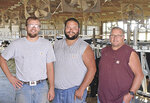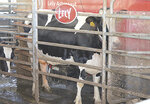CUBA CITY, Wis. – The Vosberg family is reaping the benefits of transitioning to a robotic milking system. Six months ago, the farm installed two Lely A5 robots, hoping to save on labor. While they have achieved a labor advantage, they have also seen an increase in milk production and a better way of life.
“It’s unreal,” Dale Vosberg said. “I don’t regret it at all. The cows went from a 72- to a 92-pound herd average. I used to get up at 4 in the morning and now I get up at 5.”
Vosberg milks 110 cows with his sons, Travis and Nick, in Grant County near Cuba City.
Since the addition of robots, Vosberg and his sons arrive at the farm by 5:30 a.m. Travis scrapes the barn in the morning while Nick feeds calves. Travis mixes feed while Nick and his dad retrieve the fetch cows. Travis is also in charge of herdsman work.
The trio work together to haul manure and complete fieldwork on their 400 acres of tillable land.
Vosberg is the fourth generation to milk on his farm, which became a century farm in 2014.
Prior to the robots, the Vosbergs were milking 110 cows in a worn out, 58-stall stanchion barn. Vosberg always thought the next step would be a parlor, but after visiting a few robotic farms, he began considering that route instead.
When Vosberg’s sons and father went on their annual fishing trip and hired help failed to come to work, he made the decision to go forward with robots.
“I said right then and there that I’m putting robots in and nobody’s changing my mind,” Vosberg said.
Vosberg’s main concern when considering robots was the cost. The first thing he did after deciding to go ahead with robots was to consult with an expert who explained the total cost. The outlook was better than what Vosberg had anticipated.
“I was expecting way worse than what he told me,” Vosberg said. “Everybody says you’re going to have a half a million tied up in your robots, but we didn’t.”
In 2012, the family built a freestall barn. The robots were added to the end of the freestall barn, and an additional building was put up around them.
The setup is referred to as a toll booth style. Once a cow is in the robot, she is milked and then released back to the freestall area. There is a button inside the robot room that will open a gate and redirect the cow to a holding pen. This has proved convenient for hoof trimming and herd health work.
A bigger bulk tank was installed with the addition of robots, allowing the Vosbergs to get their milk picked up every other day. They used to ship around 8,000 pounds per day, and now, they are close to 20,000 pounds every other day.
Another concern Vosberg had was transitioning the cows to the new system. After all the construction was complete, things were lined up to push cows through the robots Feb. 8. Their first time through allowed the robots to map each cow. When mapping, the milker is attached for a few seconds and the cow is sent out. Each cow only needs to be mapped once. Their information is saved and used with each milking according to the cows’ activity collars which is used to identify the animal.
Vosberg said it was an interesting experience to push cows through the robots for the first time.
“I was afraid about training the cows,” Vosberg said. “I was out in the barn, and Travis was in the robot room. I would hear all sorts of banging when the cows kicked the robots, and I thought there would be pieces laying everywhere, but it’s solid.”
The second time the cows went through the robot they were milked.
Vosberg said there was a crew of people to help for the first three days. His nutritionist, Katie Meyer, had a team of people from Vita Plus, and Vosberg said the team at Argall Dairy was helpful as well.
Vosberg said the first milking took eight hours.
“Once they got done milking, we had to wait so many hours in between then come back and start them again,” Vosberg said. “As time went on, the cows kept picking it up, and we’d have to do less and less.”
The family spent about a month running the cows through the robots. Now they have about five fetch cows at any given time, and some of those are usually fresh cows.
Travis uses the reports generated by the reports. The reports show many things including somatic cell count, temperature, heat detection and milk weights.
With definite advantages realized in labor and milk production because of the family’s new milking system, Vosberg said he is glad to be continuing the legacy with the fifth generation.
“It’s all I’ve ever done,” Vosberg said. “Everything about it is my favorite.”



Comments
No comments on this item Please log in to comment by clicking here